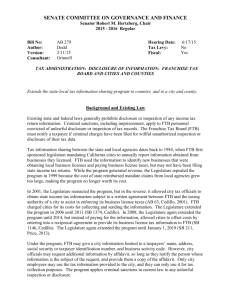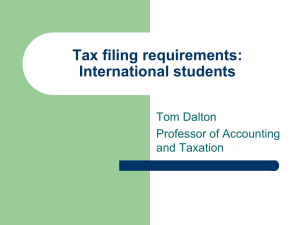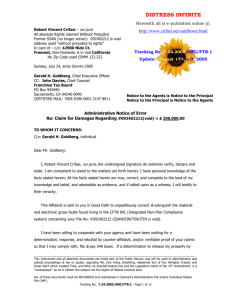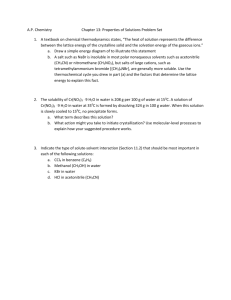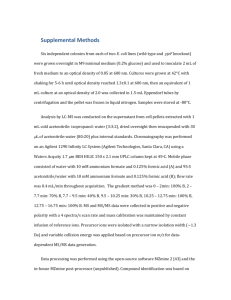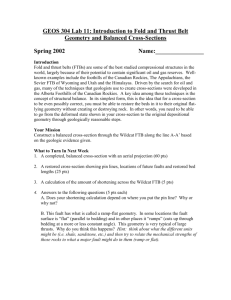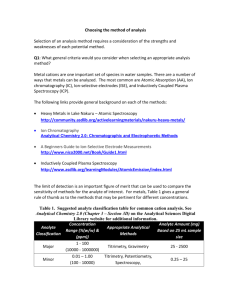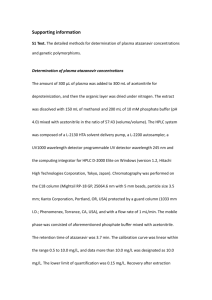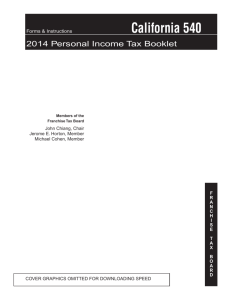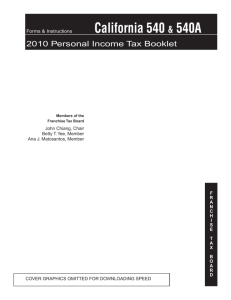Original Article Quality Assessment on Commercial Fritillariae
advertisement
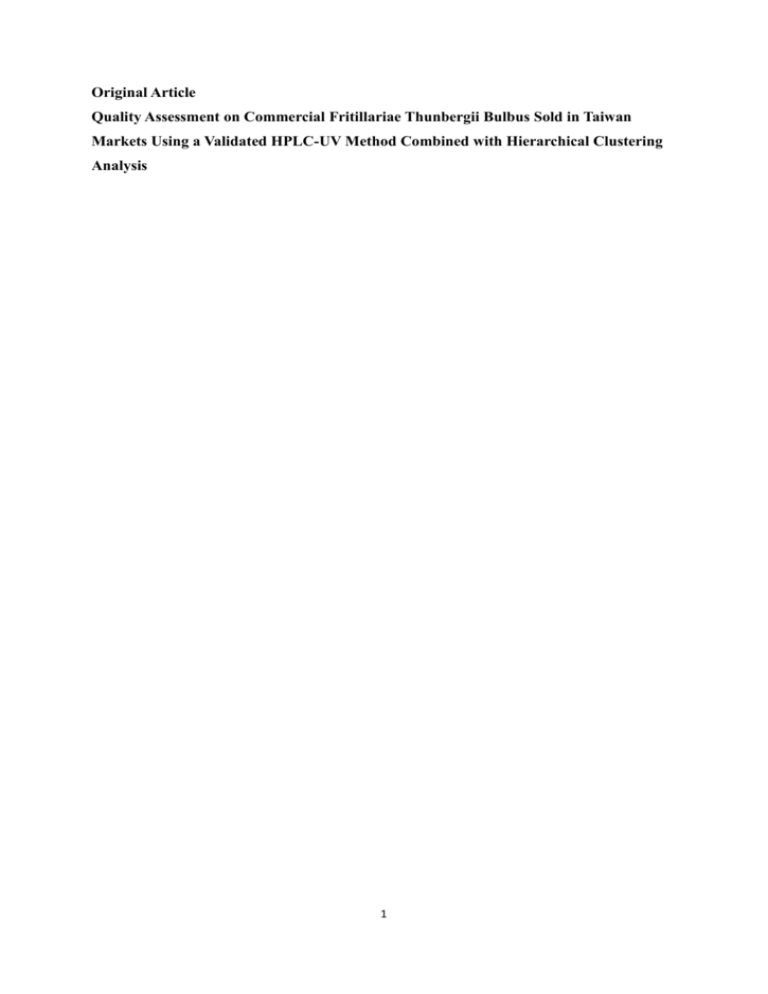
Original Article Quality Assessment on Commercial Fritillariae Thunbergii Bulbus Sold in Taiwan Markets Using a Validated HPLC-UV Method Combined with Hierarchical Clustering Analysis 1 ABSTRACT The present paper describes the development of a high performance liquid chromatography-ultraviolet detection method for quantitative determination of peimine and peiminine in Fritillariae Thunbergii Bulbus. Separation was achieved using a conventional XBridgeTM Shield RP 18 column (250 mm × 4.6 mm i.d., 3.5 μm) with photo diode array detection at 190 nm-400 nm for UV spectra and 220 nm for quantification. The mobile phase consisted of 0.03% diethylamine aqueous solution (A) and acetonitrile (B) eluted with isocratic procedure at 45:55 (A:B) over 25 min. The method was validated for linearity, limit of detection and quantification, inter- and intra-day precisions, repeatability, stability and recovery. All the validation results were satisfactory. The developed method was then applied to assay the contents of the two chemical markers in all the FTB samples collected. Based on the contents of the two analytes, hierarchical clustering analysis was performed to reveal the similarities and differences of the samples. Key words: Quality assessment, Fritillariae Thunbergii Bulbus, HPLC-UV, Hierarchical Clustering analysis 2 INTRODUCTION Fritillariae Thunbergii Bulbus (FTB), dried bulb of Fritillaria thunbergii Miq., is one of the traditional Chinese medicines commonly used to clear heat, eliminate phlegm, and relieve cough [1]. Modern pharmacological studies indicated that FTB had sound effect on hyperthyroidism [2] and prostatitis [3] and could enhance MDR reversal effect of DDP on A549/DDP cells in vitro and in vivo, and down-regulate MDR1 mRNA and P-gp expression in A549/DDP cells [4]. Peimine and peiminine are regarded as the main bioactive compounds in FTB. Intraperitoneal administration of peimine and peiminine resulted in a significant antitussive effect in mice [5]. Peimine was found to reverse MDR of A549/DDP cell line [6]. It is regulated in Chinese Pharmacopeia (edition 2010) that the total content of peimine and peiminine in qualified FTB should be not less than 0.08% [1]. However, the quantification of peimine and peiminine is difficult and challenging since the chemical structures of the two compounds are similar with the lack of UV conjugated systems (Fig. 1). Even in CP (edition 2010), evaporative light scattering detector (ELSD) has to be used for quantification of the two analytes in FTB samples [1]. However, expensiveness, poor repeatability and stability of the detector make it be unacceptable in routine analyses. Therefore, in the present study, we established and validated a high performance liquid chromatography coupled with ultraviolet detector for quantitative determination of peimine and peiminine, based on which FTB samples from different pharmacies or markets in Taiwan were analyzed. The data make us easily figure out the stability and homogeneity of the herb in Taiwan markets. MATERIAL AND METHODS I. Chemicals, solvents and herbal materials 3 Peimine and peiminine were purchased from National Institute for Control of Pharmaceutical and Biological Products. LC-grade methanol, acetonitrile were purchased from the branch company of Merck in Taipei, Taiwan. Purified water was prepared with Milli-Q system (Millipore, Milford, MA, USA). All other reagents used in the present study were of analytical grade. Herbal materials of FTB were purchased from local markets of Taiwan, which were marked as FTB-01 to FTB-10. All the specimens have been deposited in Department of Chinese Pharmaceutical Sciences and Chinese Medicine Resources, School of Pharmacy, China Medical University. II. Sample and reference preparation FTB samples were dried in a shade place and were ground into fine powder (20 mesh) using a grinder with a knife blade. 2.00 g of each FTB powder was carefully weighed into a 125 ml conical flask. 5 ml of ammonium hydroxide was then added and each sample was soaked for 1 h, after which 50 ml of dichloromethane-methanol (4:1, v/v) was added into the flask. Each sample was extracted using heat reflux at 65 ℃ for 2 h. The extract was filtered and transferred into a 100 ml-evaporation pan, which was then evaporated into dryness. The residue was dissolved and made up to 10 ml with methanol. The final volume was filtered through a 0.45 μm PVDF syringer filter (VWR Scientific, Seattle, WA) before analysis. The reference compounds of peimine and peiminine were accurately weighed respectively and were dissolved in methanol at 1165 and 1044 mg/L (stock solutions), respectively. The stock solutions were then diluted to appropriate concentrations for establishment of calibration curves. An aliquot of 10 μl of each solution was used for HPLC analyses. III. HPLC analysis 4 HPLC analyses were performed on a Waters 2695 HPLC system equipped with Waters 2998 photodiode array detector (PDA), Waters e2695 separations module and column heater module. An XBridgeTM Shield RP 18 column (250 mm × 4.6 mm i.d., 3.5 μm) was used. The mobile phase consisted of water containing 0.03% diethylamine (A) and acetonitrile (B). The optimized elution conditions were as follow: 0-20 min, 55% B. The flow rate was set at 1 ml/min and the injection volume was 10 μl. UV spectra were acquired from 190 nm to 400 nm. The auto-sampler and column compartment were maintained at 25 ℃ and 35 ℃, respectively. IV. HCA HCA was performed using SPSS (13.0) based on the contents of peimine and peiminine in different FTB samples. RESULTS AND DISCUSSION I. Optimization of extraction method The extraction methods were optimized taking the extraction efficiency of peimine and peiminine as indicators. Ultrasonic and reflux extraction were investigated at room temperature using dichloromethane-methanol (4:1, v/v) as extraction solvent. As a result, the total contents of peimine and peiminine obtained by using heat reflux extraction were both higher than the values obtained by using ultrasonic extraction (p < 0.05). Furthermore, the two compounds were almost extracted completely (> 99%) for 2 hours. Finally, the optimal extraction procedure was finalized in “Sample and reference preparation”. II. Optimization of chromatographic conditions 5 To develop a reliable chromatographic fingerprinting method, an optimized strategy for HPLC conditions was performed. To obtain sharp and symmetrical peaks, different mobile phase systems, methanol–water, acetonitrile–water, acetonitrile–water (0.5% formic acid), acetonitrile–water (0.03% diethylamine) elution systems were tested. As a result, good resolution, baseline, sharp and symmetrical peaks were obtained by using acetonitrile–water (0.03% diethylamine) system. A few columns (Waters XTerra RP18, Thermo Ascentis C18 and Grace Alltima C18) were screened before Waters XBridge C18 column (250 mm × 4.6 mm i.d., 3.5 μm) was finally selected as the column of choice. To obtain a sufficient large number of detectable peaks on the chromatographic fingerprints, PAD full scan (190–400 nm) was used for investigating all the main peaks and finally 220 nm was selected as detection wavelength. Representative chromatographic fingerprint obtained from FTB-01 is shown in Fig. 1. Different column temperatures at 20, 25, 30 and 35 ℃ were also investigated. Although chromatograms detected at different temperatures didn’t show obvious differences, 35 ℃ was selected as the preferable one in order to minimize the influences from room temperature on the chromatograms. In the process of gradient optimization, gradient time, gradient procedure and initial composition of the mobile phase were taken into consideration. Finally, the gradient procedure was decided, as described in “HPLC Analysis”. III. Validation of quantitative analytical method The HPLC method was validated by defining the limits of detection (LOD) and quantification (LOQ), linearity, inter-day and intra-day precisions, repeatability, stability, and recovery. The calibration curves were plotted on the basis of linear regression analysis of the integrated peak areas (y) versus concentrations (x, mg/L) of the two analytes at five different levels. LOD and LOQ values for each analyte under the present chromatographic conditions were determined in terms of baseline noise, according to the IUPAC definition. LOD was 6 determined as the analyte concentration yielding signal with a single-to-noise (S/N) ratio at 3:1, whereas the LOQ was defined as the analyte concentration yielding signal with S/N ratio at 10:1. The results of regression equations, correlation coefficients, linear ranges, LODs and LOQs for peimine and peiminine are shown in Table 1. The correlation coefficient (R2) of the regression equation for each analyte indicates good linearity, being better than 0.999. Intra- and inter-day variations were chosen to determine the precision of the developed method. For intra-day variability test, one of the mixed standard solutions (peimine, 97.1 mg/L; peiminine, 43.5 mg/L) was analyzed five times within one day, while for inter-day variability test, the mixed standard solution was examined in triplicate each day on three consecutive days. The RSDs for the peak areas were calculated as measurements of precisions. The RSDs of intra-day variation for peimine and peiminine were less than 3.50%, and the RSDs of inter-day variation for peimine and peiminine were less than 4.00%, as shown in Table 2. Repeatability was evaluated by analyzing five different working solutions prepared from the same sample (FTB-01). RSD values were 1.86% and 2.17% for peimine and peiminine, respectively (Table 2). Stability was determined using repeated analyses of the same sample solution at different times during storage at room temperature (approx. 25 ℃) for 24 h. The RSD values of peak areas of peimine and peiminine were 3.99% and 1.68%, respectively (Table 2), indicating that the stability of the sample solution within one day was good. Recovery test was determined using spiked FTB samples. A portion of 1.0000 g of FTB sample was individually spiked with 0.5010 mg of peimine and 0.3132 mg of peiminine, respectively. Five replicate samples were extracted and analyzed according to the procedures described above. As shown in Table 3, the mean recovery (n=5, mean ± SD) are found to be 94.18% ± 3.75 and 91.56 ± 2.11, respectively. These RSD values indicate that the proposed methodology is reproducible and suitable for the 7 quantitative determination of peimine and peiminine in FTB samples. IV. Quantitative determination of peimine and peiminine in FTB samples The developed HPLC-UV analytical method was applied for the quantitative determination of peimine and peiminine in ten FTB samples. The calibration curves were used to calculate the contents of the two compounds in the samples (data are shown in Table 4). Firstly, the contents of peimine and peiminine in different samples varied from 0.0135% to 0.1331%, 0.0321% to 0.0605%, respectively. FTB-09 was found to have the highest content of peimine at 0.1331%, meanwhile, FTB-06 had the highest content of peiminine at 0.0605%. The lowest content of peimine and peiminine were both found in FTB-12 at 0.0135% and 0.0321, respectively. Secondly, the highest total content of peimine plus peiminine was found in FTB-09 at 0.1934%, however, FTB-12 gave the lowest one at 0.0456%. Thirdly, according to the specification in CP (edition 2010) that the total content of peimine and peiminine should not be less than 0.080%, FTB-12 was unqualified herbs that could not be used clinically. V. HCA HCA is a statistical method for finding relatively homogeneous clusters of cases based on measured characteristics. The contents of peimine and peiminine were defined as the variables in the analysis so as to analyze, differentiate and classify the 12 bathes of BTF samples. Ward’s method, which is a very efficient method for the analysis of variance between clusters, was applied, and Square Euclidean distance was selected as a measurement. A dendrogram was generated (Fig. 2), which revealed the relationships among the samples. Twelve tested samples of BTF were divided into two main clusters, cluster A and cluster B. Sample no. 9 was in cluster A and other samples were in cluster B, which was then divided into two subgroups. Sample no. 12 was in group B-1, and other samples were in group B-2.The result indicated the similarities and differences between the samples. Sample no. 9 had the highest 8 content of peimine at 0.1331% and the second highest content of peiminine at 0.0603%. That’s why it was clustered individually in cluster A. Sample no. 12 had the lowest contents of the two analytes at 0.0135% and 0.0321%, respectively, making it be clustered in group B-1. All in all, from the dendrogram, we could easily and intuitively see the similarities and differences of the tested BTF samples. CONCLUSIONS An HPLC-UV method was developed and validated after detailed investigation on extraction of chemical compounds from FTB using different solvents and methods. The method was validated to be accurate, reliable, and have good repeatability, which was then applied to analyze the two chemical markers in different FTB samples. The contents of peimine and peiminine were then used as variables to performed HCA. From the dendrogram obtained, we could easily see the similarities and differences of the samples. Since ELSD has many disadvantages including expensiveness of the facility, poor repeatability and stability of the data, this established method using UV detector is very valuable for routine analyses. 9 REFERENCES 1. The State Pharmacopoeia Commission of the People’s Republic of China. Pharmacopoeia of the People’s Republic of China. 2010 ed. Beijing: Chemical Industry Press; 2010 2. Lin MB, Wan LL, Zhou ZY. Protection effect of Fritillaria thunbergii against hyperthyroidism in rats and mice. Zhongguo Yao Fang 2010;21:1362-3. 3. Xia JX, Han L, Zhou XH, et al. The effect of Zhejiang Fritillaria Thunbergii against immunological CP/CPPS. Zhonghua Zhong Yi Yao Xue Kan 2011;29:1023-5. 4. Li ZH, An C, Hu KW, Zhou KH, Duan HH, Tang MK. Multidrug resistance reversal activity of total alkaloids from Fritillaria thunbergii on cisplatin-resistant human lung adenocarcinoma A549/DDP cells. Zhongguo Yao Li Xue Yu Du Li Xue Za Zhi 2013; 27:315-20. 5. Ou M. Chinese-English manual of common-used in Traditional Chinese Medicine. Guangdong: Guangdong Science and Technology; 1992. 6. Tang XY, Tang YX. Efficiency and mechanisms of peimine reversing multi-drug resistance of A549/DDP cell line. Shandong Yi Yao 2012;52:4-6. 10 Table 1. The results of LODs, LOQs, regression equations, correlation coefficients and linearity ranges of peimine and peiminine. Analyte Regression equation Correlation coefficient Linearity range (mg/L) LOD (μg/mL) LOQ (μg/mL) Peimine y = 889972x + 2447.4 0.9999 24.3 ~ 388.3 1.67 6.07 Peiminine y = 895452x – 1376.1 0.9999 10.9 ~ 174.0 5.44 14.26 11 Table 2. Results of precision, repeatability and stability tests. Precision (RSD, %) Analyte Repeatability (RSD, %) Stability (RSD, %) Intra-day (n = 5) Inter-day (n = 5) Peimine 1.99 2.06 1.86 3.99 Peiminine 3.39 3.51 2.17 1.68 12 Table 3. Accuracy of HPLC-UV method for determination of peimine and peiminine. Analyte Sample Weight (g) Original (mg) Spiked (mg) Found (mg) Recovery (%) Mean Recovery (%) RSD (%) 0.9755 0.4841 0.5010 0.9827 99.53 0.9702 0.4815 0.5010 0.9332 90.17 0.9712 0.4820 0.5010 0.9454 92.51 0.9901 0.4914 0.5010 0.9537 92.30 0.9961 0.4944 0.5010 0.9620 93.34 0.9755 0.2915 0.3132 0.5741 90.25 0.9702 0.2899 0.3132 0.5820 93.25 Peiminine 0.9712 0.2902 0.3132 0.5728 90.22 0.9901 0.2958 0.3132 0.5808 90.99 0.9961 0.2976 0.3132 0.5936 94.49 Peimine 13 94.18 3.75 91.56 2.11 Table 4. Contents of peimine and peiminine in FTB samples. Content a (%) Sample no. Peimine Peiminine Total FTB-01 0.0550 0.0331 0.0881 FTB-02 0.0781 0.0506 0.1287 FTB-03 0.0685 0.0492 0.1177 FTB-04 0.0576 0.0401 0.0977 FTB-05 0.0589 0.0451 0.1040 FTB-06 0.0833 0.0605 0.1438 FTB-07 0.0669 0.0509 0.1178 FTB-08 0.0663 0.0418 0.1081 FTB-09 0.1331 0.0603 0.1934 FTB-10 0.0674 0.0466 0.1140 FTB-11 0.0688 0.0492 0.1179 FTB-12 0.0135 0.0321 0.0456 a Calculated with dried FTB samples. 14 Figure legends Figure 1: Representative chromatograms of (A) mixed standards of peimine and peiminine and (B) FTB-01 detected at 220 nm. Figure 2: Dendrogram of HCA for the 12 batches FTB samples. The hierarchical clustering was carried out using SPSS (13.0) software. Ward’s method was applied, and Squared Euclidean distance was selected as a measurement. 15
